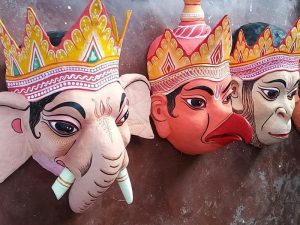GI tag for Majuli masks of Assam: History, cultural significance of the centuries-old art form.


GI tag for Majuli masks of Assam: History, cultural significance of the centuries-old art form.
Current Affairs Daily Articles & Editorials
La Excellence IAS Academy | March 13, 2024 | History-Art and Culture
| Syllabus: GS-I, Subject: History-Art and Culture, Topic: Art & Architecture , Issue: GI Tag |
Context: The traditional Majuli masks in Assam were given a Geographical Indication (GI) tag.

Majuli masks:
- These are handmade masks used to depict characters in bhaonas (theatrical performances) under the neo-Vaishnavite tradition.
- The masks can depict gods, goddesses, demons, animals and birds.
- Made of: Bamboo, clay, dung, cloth, cotton, wood and other materials.
- The mask-making tradition is practised in Sattras (monasteries that serve as centres of religious, social, and cultural life, established by Srimanta Sankardev).
Majuli manuscript painting
- Also received the GI tag.
- It is a form of painting done on sanchi pat, or manuscripts made of the bark of the sanchi or agar tree, using homemade ink.
Srimanta Sankardeva (1449-1568):
- A revered Assamese saint-scholar, poet, playwright, and social-religious reformer.
- Established neo-vaishnavism in Assam known as Ekasarana Dharma (Shelter-in-One Religion), emphasising devotion to Krishna.
- Rejected the caste system and offered a path to salvation through devotion, open to all genders and social classes.
- Credited with creating new forms of
- music (Borgeet),
- theatrical performances (Ankia Naat),
- dance (Sattriya), and
- literary language (Brajavali).
Prelims Connect (Places in news):
| Majuli Island:
● Largest river island in the world and the seat of Assam’s neo-Vaishnavite tradition. ● Location: In Assam, formed by the Brahmaputra River to the south and east, the Subansiri River to the west.
|
Source: Indian Express
Leave a Reply
You must be logged in to post a comment.

